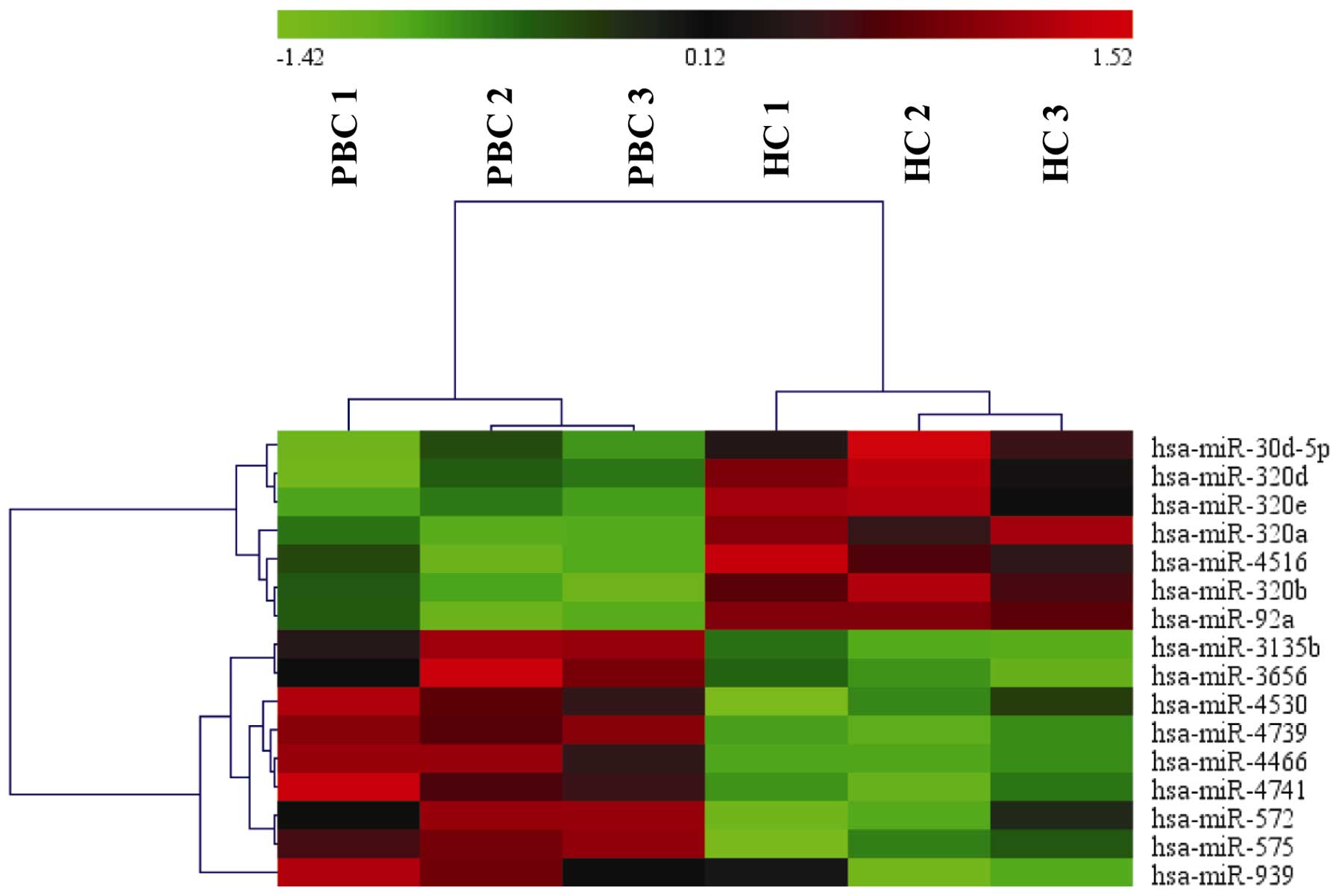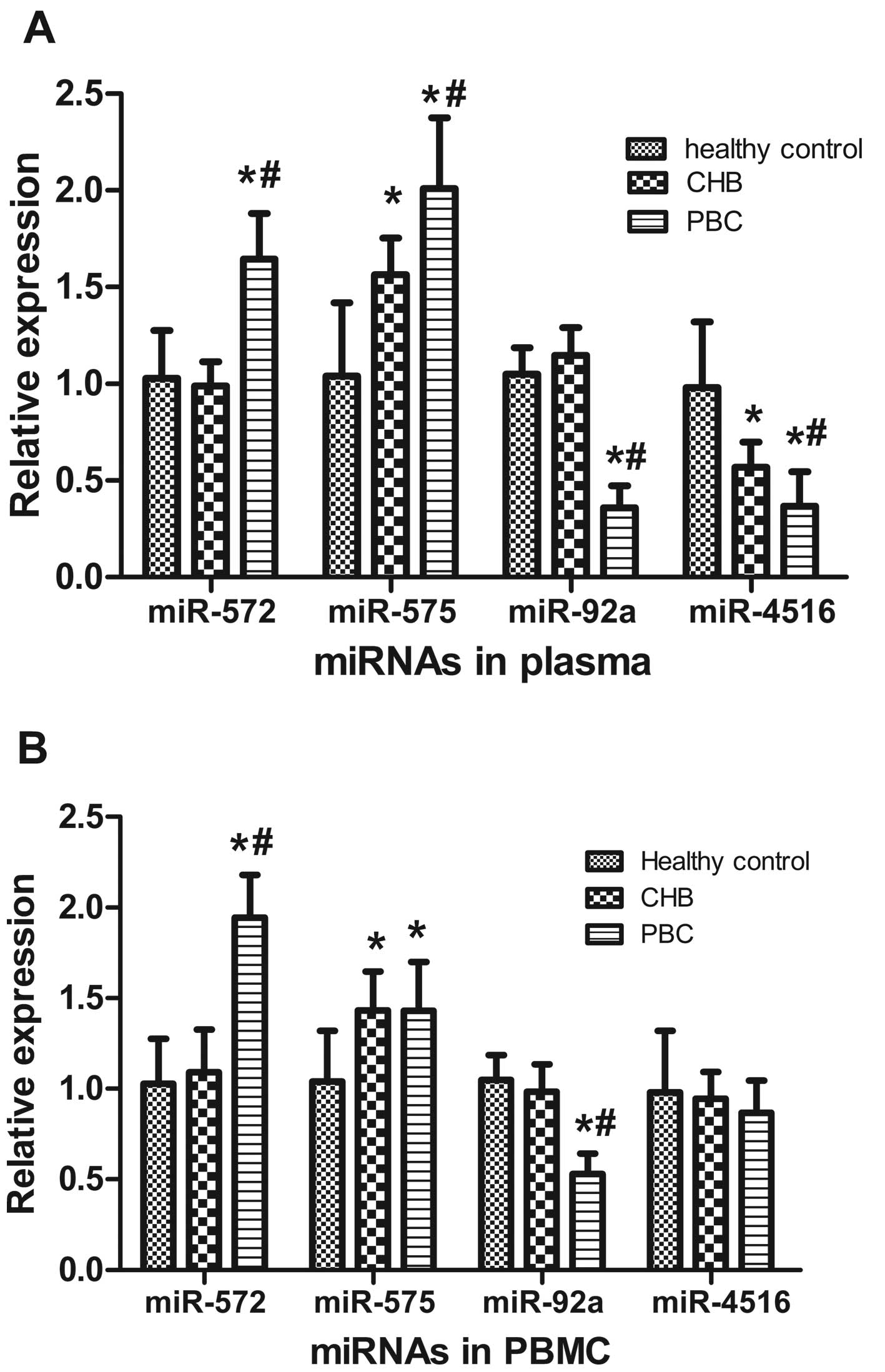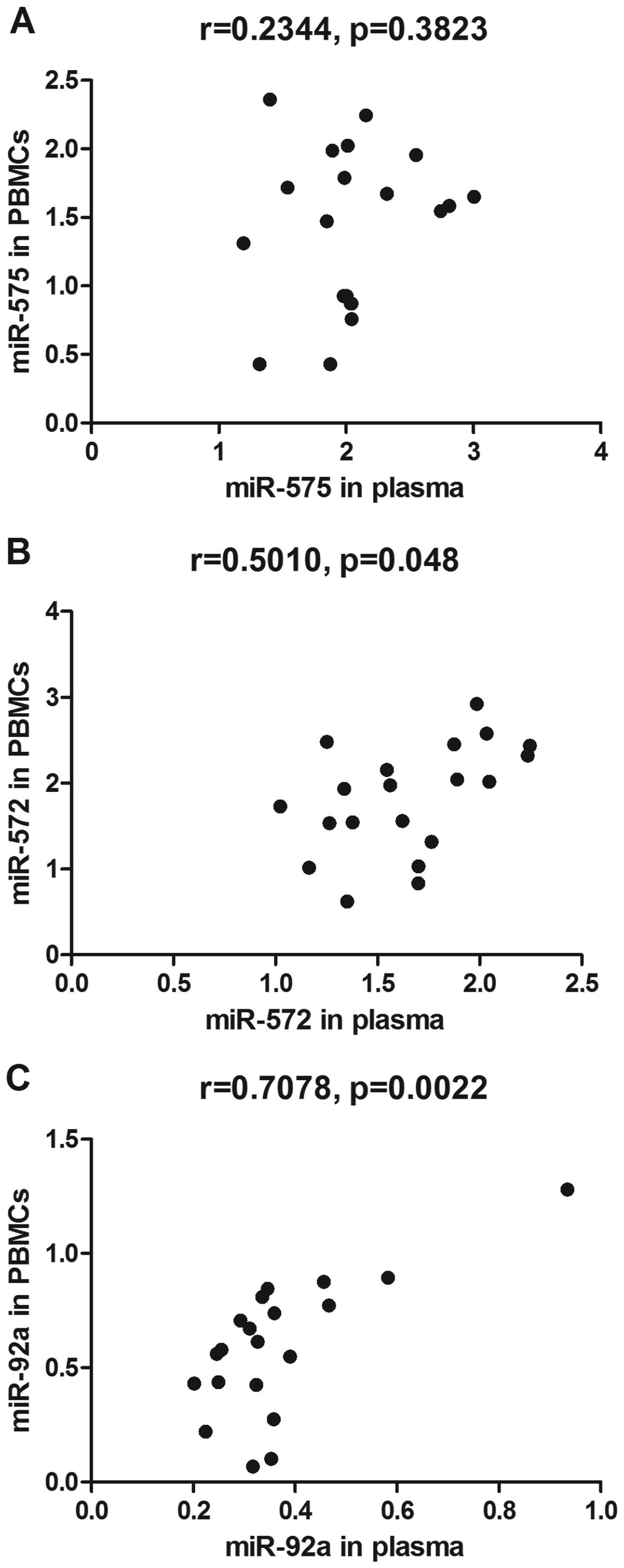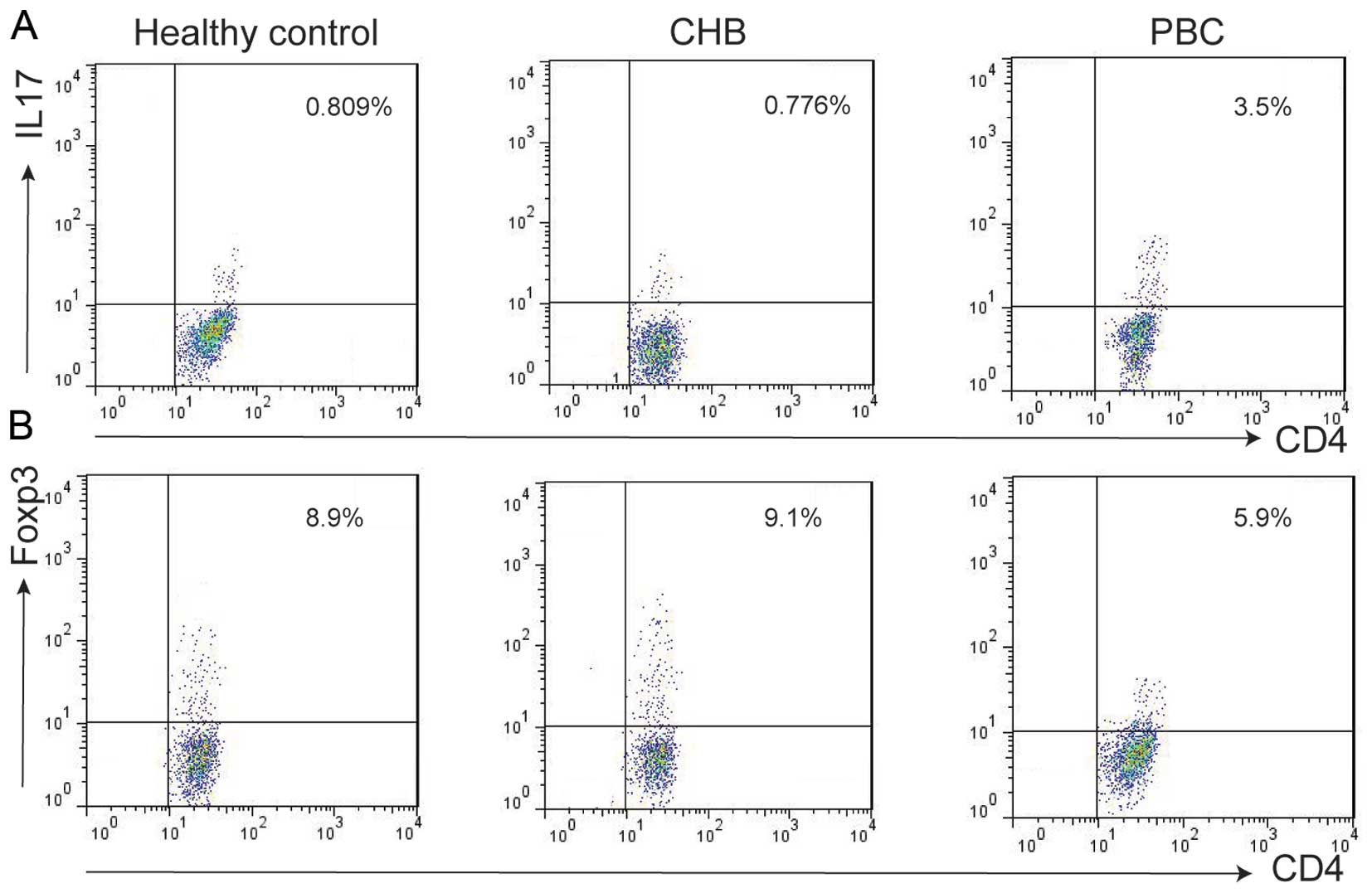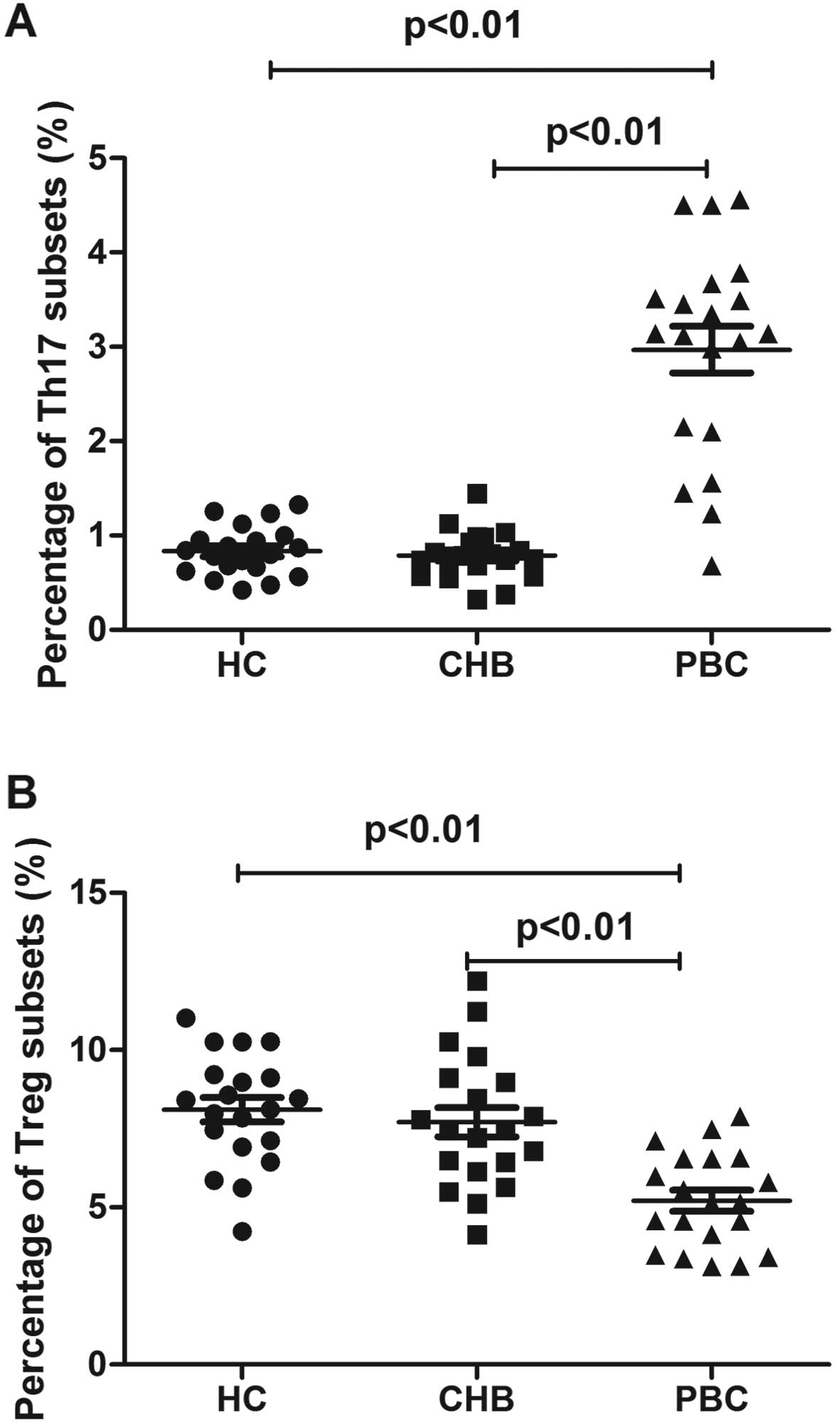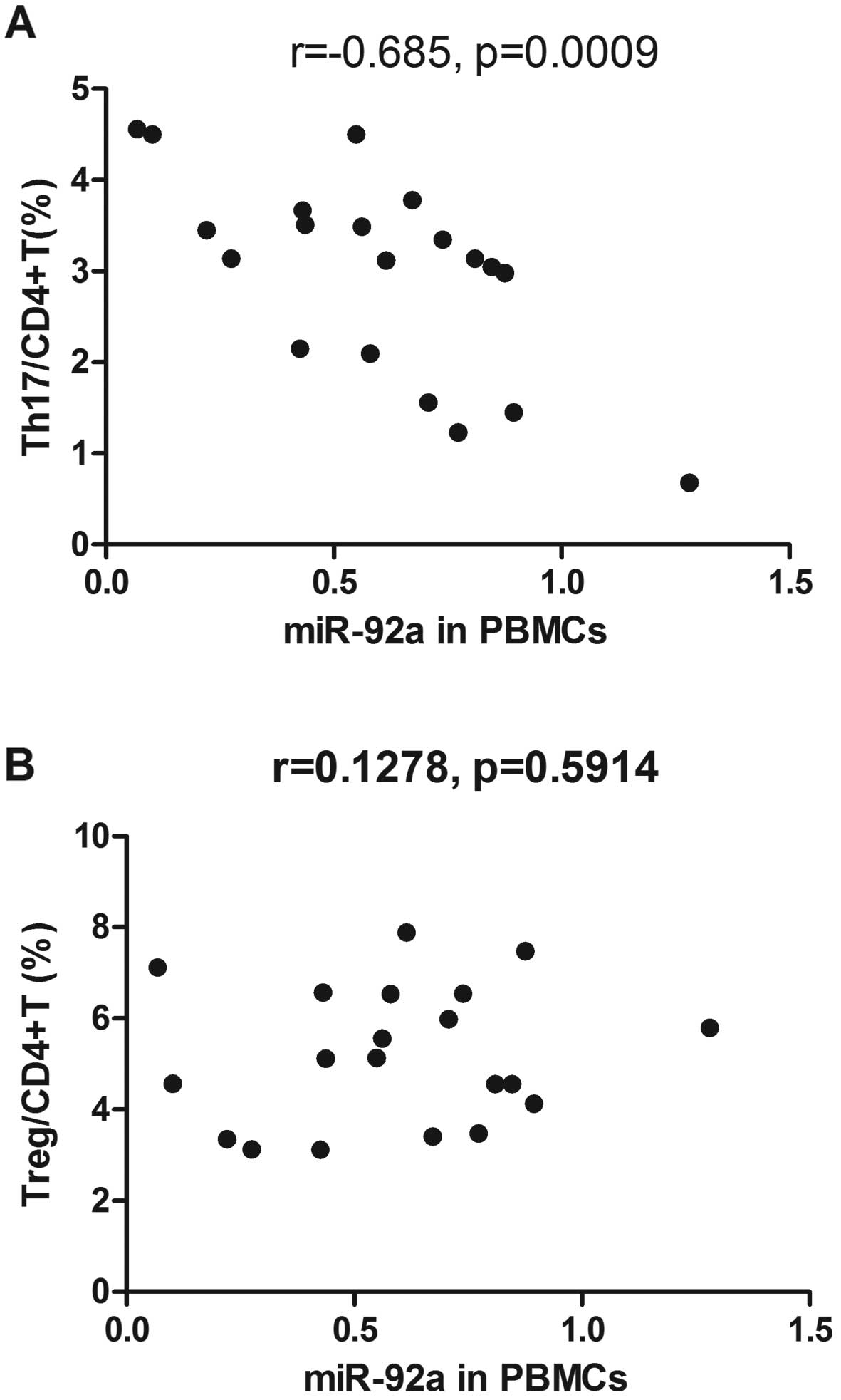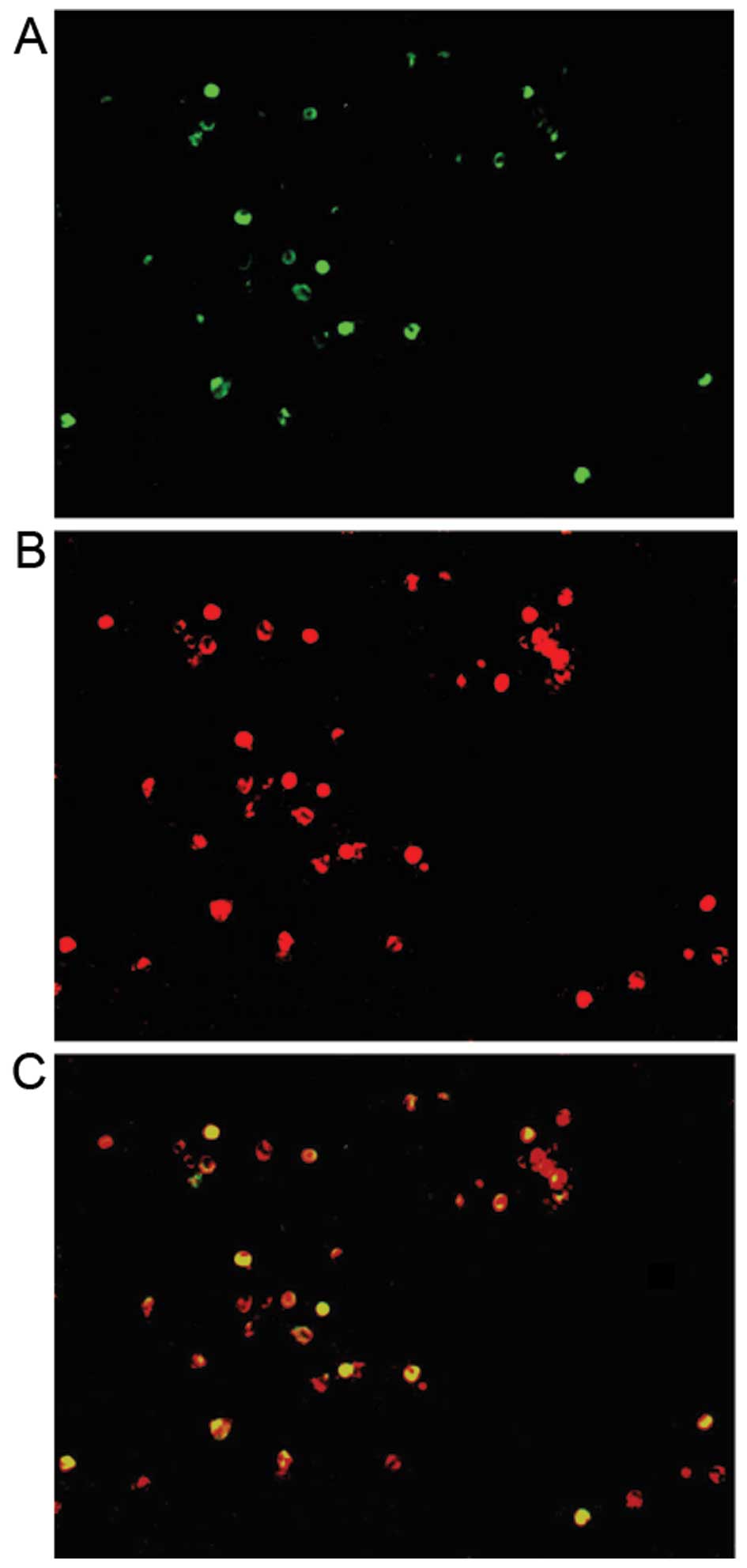Altered expression of miR-92a correlates with Th17 cell frequency in patients with primary biliary cirrhosis
- Authors:
- Published online on: May 27, 2016 https://doi.org/10.3892/ijmm.2016.2610
- Pages: 131-138
-
Copyright: © Liang et al. This is an open access article distributed under the terms of Creative Commons Attribution License.
Abstract
Introduction
MicroRNAs (miRNAs or miRs) are a novel class of small, non-coding RNAs that post-transcriptionally regulate gene expression in eukaryotic organisms (1). In humans, over 1,900 miRNAs have been reported (2), and 30% of human genes may be regulated by these miRNAs (3). To date, it has been demonstrated that miRNAs are involved in various biological processes, including cell activation, differentiation and apoptosis (4,5). In addition, several miRNAs have also been found to be involved in the regulation of immune cell development and immune signaling pathways (6). It has been previously reported that the aberrant expression of miRNAs may play significant roles in the pathogenesis of several autoimmune diseases (7-9). For example, in systemic lupus erythematosus, miR-146 is downregulated; decreased miR-146 expression is associated with prolonged interferon (IFN) signaling, which results in increased disease activity (10). In multiple sclerosis, miR-326 regulates the differentiatiation of a subset of interleukin (IL)-17-producing T helper cells (Th17) and levels correlate with the pathogenesis of the disease (11).
Primary biliary cirrhosis (PBC) is an organ-specific autoimmune disease that is characterized by the presence of serum anti-mitochondrial antibodies (AMA) and immune-mediated destruction of the intrahepatic bile ducts (12,13). Although there has been a substantial increase in the prevalence of PBC, the pathogenesis of this disease remains unclear (14). Mounting evidence suggests that CD4+ T cells play a critical role in immune-mediated cholangitis in PBC (15). Traditionally, PBC has been associated with an imbalance of T helper type 1 (Th1)/T helper type 2 (Th2) cells as demonstrated by increased IFN-γ levels and decreased IL-10 and IL-4 levels (16,17). A previous study has detected a decrease in circulating FoxP3+ regulatory T (Treg) cell frequency and an increase in Th17 frequency in the peripheral blood of patients with PBC, providing an opportunity to explore the mechanisms of PBC (18). However, the underlying mechanisms that cause the imbalance in CD4+ T cells in PBC remain to be elucidated.
The aim of the present study was to examine the expression pattern of miRNAs in the plasma and peripheral blood mononuclear cells (PBMCs) from patients with PBC, and to analyze the role of these miRNAs in the development of PBC.
Materials and methods
Study population
All 20 patients (16 females, four males; mean age, 43.2±10.5 years) were recruited from the Infectious Disease Department of Songjiang Central Hospital (Shanghai, China). The diagnosis of PBC was based on internationally established criteria (the consensus of diagnosis and treatment of PBC 2015). Twenty patients with chronic hepatitis B (CHB) and 20 healthy controls matched with PBC patients based on gender and age were also included in this study. The study was approved by the Research Ethics Committee of SongJiang Central Hospital (Shanghai, China), and written informed consent was obtained from each patient.
Sample preparation
Blood samples (10 ml) from each participant were collected in EDTA-treated tubes. Plasma was separated by centrifugation at 3,000 × g for 10 min, and PBMCs were isolated through density gradient centrifugation within 1 h (Lymphoprep; Axis-Shield, Oslo, Norway).
Microarray analysis
An Agilent human miRNA 18.0 micro-array (Agilent Technologies, Santa Clara, CA, USA) was used to identify miRNAs in the plasma of three PBC patients and three healthy controls. Total RNA was extracted and purified using the mirVana™ isolation kit (Ambion, Austin, TX, USA) according to the manufacturer's instructions. The miRNA in total RNA was labeled and hybridized using the miRNA Complete Labeling and Hyb kit (Agilent Technologies). Slides were then scanned using an Agilent Microarray Scanner and Feature Extraction software 10.7 (both from Agilent Technologies). The raw data were normalized using the quantile algorithm, GeneSpring Software 11.0 (Agilent Technologies).
Reverse transcription-quantitative polymerase chain reaction (RT-qPCR) verification of miRNA in plasma and PBMCs
Differentially expressed miRNAs in the plasma and PBMCs from 60 samples were validated by RT-qPCR (including the samples used in miRNA array). Total RNA was isolated using an miRcute miRNA isolation kit (Tiangen Biotech Co., Ltd., Beijing, China). cDNA was synthesized from total RNA using miRNA-specific stem-loop RT primers and an miRNA Reverse Transcription kit (Takara Bio, Otsu, Japan). qPCR was performed using SYBR-Green PCR Master Mix and an ABI 7500 system (both from Applied Biosystems, Foster City, CA, USA). All reactions were performed in triplicate. The mean value of the threshold cycle (Ct) was calculated relative to U6, an endogenous RNA that served as a control. The relative expression of each miRNA was calculated using the 2−ΔΔCt method.
Flow cytometric analysis
The PBMCs were isolated by density gradient centrifugation and incubated for 4 h at 37°C in 5% CO2 in the presence of 25 ng/ml phorbol myristate acetate, 1 µg/ml ionomycin and 2 µM monensin. The cells were stained for 30 min with fluorescein isothiocyanate-labeled anti-human CD4 antibodies (Cat. no. 11-0048-42). The cells were fixed and permeabilized using Perm/Fix solution. Intracellular staining was performed with phycoerythrin (PE)-conjugated anti-human IL-17A (Cat. no. 12-7178-42) or PE-conjugated anti-human Foxp3 (Cat. no. 12-4777-42) monoclonal antibodies. Isotype controls were used to confirm antibody specificity. All cells were resuspended in washing buffer and analyzed by flow cytometry. All reagents were purchased from eBioscience, Inc. (San Diego, CA, USA).
Dual staining combining fluorescence in situ hybridization (FISH) and immunohistochemistry (IHC)
Firstly, the freshly-isolated PBMCs were incubated with 5 µg/ml anti-CD3, 2 µg/ml anti-CD28, 20 ng/ml IL-6, 2 ng/ml TGF-β1, 10 µg/ml anti-IFN-γ and anti-IL-4 (eBioscience, Inc.). Subsequently, 25 ng/ml phorbol myristate acetate, 1 µg/ml ionomycin, and 2 µM monensin were added and the cells were incubated for another 4 h. Finally, the cells were collected and seeded on polyane-covered slides.
For detection of miR-92a, the slides were fixed for 15 min at 25°C with paraformaldehyde and washed in phosphate-buffered saline (PBS) three times. After digestion with proteinase K for 10 min at 25°C, the slides were washed with PBS and hydrated in ethanol solutions. Hybridization with the DIG-labeled miR-92a probe, U6 (positive control), or scrambled miRNA (negative control) was performed for 1 h at 54°C in hybridization buffer. Following hybridization, the sections were washed with 2X SSC, 1X SSC and 0.2X SSC, blocked with 4% horse serum, and incubated for 12 h at 4°C with alkaline phosphatase-conjugated Fab-anti-DIG antibody (Cat. no. ab119345; Abcam, Cambridge, MA, USA) in 1% sheep serum. Staining was performed by TSA Plus Direct-Cyanine 3 deposition following the manufacturer's instructions (PerkinElmer, Inc., Waltham, MA, USA).
For IL-17A detection, the sections were first blocked using PBS-BB (PBS containing 0.2% powdered skim milk, 1 % bovine serum albumin and 0.3% Triton X-100) for 30 min, followed by incubation for 1 h at room temperature with the mouse anti-human IL-17A monoclonal antibody (Cat. no. 14-7179-82; eBioscience, Inc.). After washing, we used the TSA Plus Direct-Green kit according to the manufacturer's instructions (PerkinElmer, Inc., Shelton, CT, USA). Finally, the sections were incubated with 4′,6-diamidino-2-phenylindole for 5 min, covered with coverslips and analyzed under a laser scanning confocal microscope (TCSSP2; Leica, Wetzlar, Germany).
Statistical analysis
For microarray analysis, Student's t-tests were used to differentiate the expression of miRNAs among the patients with PBC and the healthy controls. For RT-qPCR data, one-way analysis of variance (ANOVA) was used to determine overall differences between independent groups. The Spearman's correlation coefficient was used to evaluate correlations between variables. A p-value <0.05 was considered to indicate a statistically significant difference.
Results
miRNA expression profile in plasma obtained from patients with PBC
The microarray analysis of plasma from three patients with PBC and three healthy controls identified 16 miRNAs that were differentially expressed (Fig. 1), and of these, nine miRNAs were upregulated and seven miRNAs were downregulated in the patients with PBC (Table I).
Table IDifferentially expressed miRNAs in plasma from patients with PBC compared with healthy controls. |
RT-qPCR validation of miRNA microarray results
RT-qPCR was performed to confirm the differential expression of miRNAs identified by microarray analysis. In addition to comparisons with the healthy controls, 20 patients with CHB were also included in this study. Validation of miRNA expression was conducted in all samples (20 patients with PBC, 20 patients with CHB and 20 healthy controls). Among the 16 miRNAs, two miRNAs (miR-572 and miR-575) were upregulated in the plasma of patients with PBC compared with the healthy controls and the patients with CHB. Two miRNAs (miR-92a and miR-4516) were downregulated compared with the healthy controls and the patients with CHB (Fig. 2A). There were no differences in the expression of other miRNAs among the patients with PBC or CHB and the healthy controls (data not shown).
Expression patterns of miRNAs in PBMCs compared with those in plasma
We also analyzed the expression of the four validated miRNAs in PBMCs from the patients with PBC or CHB, and the healthy controls using RT-qPCR. In the PBMCs, miR-572 was significantly increased in the patients with PBC compared with the healthy controls and patients with CHB. miR-575 was increased in the patients with PBC compared with the healthy controls; however, miR-575 levels did not differ from those in the patients with CHB. miR-92a was significantly decreased in the patients with PBC compared with the healthy controls and patients with CHB. miR-4516 expression was unchanged in the PBMCs from the patients with PBC compared with the healthy controls and patients with CHB, which differed from the plasma expression pattern (Fig. 2B).
To determine whether there was a correlation between differentially expressed miRNAs in PBMCs and in plasma, Spearman's correlation analyses were performed. The results showed that expression of miR-572 and miR-92a in the PBMCs positively correlated with their expression in the plasma (Fig. 3B and C). No significant correlations were observed between the expression of miR-575 in the plasma and in the PBMCs (Fig. 3A).
Imbalanced T cell subsets in patients with PBC
We examined the subset population of T cells from PBMCs isolated from patients with PBC or CHB, and healthy controls using flow cytometry. Th17 cell populations were increased in patients with PBC (2.9±1.1%) compared with those in patients with CHB (0.7±0.2%) and the healthy controls (0.8±0.2%) (Figs. 4A and 5A). The Treg cell population was decreased in the patients with PBC (5.2±1.5%) vs. the patients with CHB (7.7±2.1%) and healthy controls (8.1±1.7%) (Figs. 4B and 5B).
Correlation between miRNAs and T cell subset frequencies
We analyzed the relationship between differentially expressed miRNAs and the Th cell subset imbalance in the patients with PBC using Spearman's correlation analyses. These analyses revealed that miR-92a expression in the PBMCs inversely correlated with the Th17 cell population in the patients with PBC (Fig. 6A); however, there was no correlation with the frequency of Treg cells (Fig. 6B). There was no correlation between the expression of other miRNAs and the frequencies of Th cell subsets (data not shown).
Co-expression of miR-92a and IL-17A in PBMCs isolated from patients with PBC
To determine whether miR-92a is involved in Th17 cell differentiation, we evaluated the expression of miR-92a in PBMCs using sequential miR-92a FISH and IL-17A IHC. Double staining revealed that both miR-92a and IL-17A were observed in a subset of PBMCs from patients with PBC (Fig. 7C). Additionally, all IL-17A-positive cells (Fig. 7B) expressed miR-92a (Fig. 7A).
Discussion
Changes in miRNA expression have been reported in several human diseases, including hepatocellular carcinoma (HCC) and lung cancer (19–21). However, there is limited information regarding the expression of miRNAs in PBC (22). In the present study, microarray analysis was performed in order to screen the miRNA expression profile in the plasma of patients with PBC. We identified 16 miRNAs that were differentially expressed. To determine whether these differentially expressed miRNAs are involved in the development of PBC, we confirmed their expression in PBMCs and plasma from patients with PBC or CHB as well as healthy controls using RT-qPCR. Our results showed that miR-92a and miR-4516 were downregulated in the plasma from patients with PBC compared with their expression in healthy controls and patients with CHB, whereas miR-572 and miR-575 were upregulated in the plasma from patients with PBC. However, the expression of other miRNAs was not significantly altered in the plasma from patients with PBC. In PBMCs, miR-572 expression was significantly increased in patients with PBC compared with that in the healthy controls and patients with CHB. miR-575 was increased in the patients with PBC compared with healthy controls; however, there was no difference in expression compared with that in the patients with CHB. miR-92a was significantly decreased in the patients with PBC compared with the healthy controls and patients with CHB. miR-4516 expression was unchanged in the PBMCs from patients with PBC compared with the healthy controls and the patients with CHB, which differed from the expression pattern in plasma. In order to determine whether differentially expressed miRNAs in plasma were derived from the immune system, correlation analyses of miRNA expression in the plasma and PBMCs were then performed. The results demonstrated that the expression of miR-572 and miR-92a in PBMCs positively correlated with the expression in the plasma. However, there was no correlation between miR-575 levels in the plasma and the PBMCs. We hypothesized that miR-575 upregulation may be derived from the overactivity of immune cells as well as from hepatocyte injury.
Immune cells, particularly CD4+ T cells, play an important role in immune-mediated cholangitis in PBC (15). Traditionally, based on their cytokine production profile, CD4+ T cells are divided into two subsets: Th1 and Th2. Th1 cells, characterized by the production of IFN-γ, are responsible for immunity against intracellular pathogens, whereas Th2 cells, characterized by IL-4, IL-5 and IL-13 secretion, play important roles in clearing extracellular pathogens and mediating allergic responses (23). Two additional subsets, Th17 and Treg, have been classified (24,25). Th17 cells belong to the pro-inflammatory Th cell subset, which induce tissue inflammation through IL-17A secretion, rather than IFN-γ or IL-4. Treg cells directly contact or secrete suppressive cytokines that suppress inflammation (26,27). Each subset plays a unique role, and the dysregulation of subset differentiation has been associated with disease (28,29). An imbalance between Th17/Treg cells has been reported in the progression of atherosclerosis (30). In the present study, in addition to observing the altered expression of miRNAs in PBMCs, we also confirmed the frequency of T cell subsets in patients with PBC. Our results showed that Th17 cells were upregulated and Treg cells were down-regulated in patients with PBC, which is in agreement with previous findings (18).
Mounting evidence suggests that miRNAs are important modulators of Th cell differentiation and effector function. The first study regarding miRNA-mediated regulation of Th cell differentiation involved Dicer-deficient CD4+ T cells, which exhibited increased differentiation into the Th1 cell subset, with increased production of IFN-γ (31). Functional screens in DGCR8-deficient CD4+ T cells showed that the high expression of miR-29a in naive T cells inhibited Th1 cell differentiation and IFN-γ expression (32). Several other miRNAs were also reported to regulate the differentiation and function of Th1 cells (33-35). In addition to Th1 cell regulation, the miRNA-mediated regulation of other CD4+ T cells has also been studied. In miR-155 knockout (miR-155-KO or miR-155−/−) mice, both Th1 and Th17 cells were defective (36). Furthermore, the proportion and absolute number of Treg cells were also smaller in miR-155-deficient mice (37). In summary, these studies indicated that miRNAs are essential for the differentiation of Th cell subsets. In the present study, we demonstrated an imbalance of Th17/Treg cells in patients with PBC, with an increased peripheral Th17 population and simultaneously decreased Treg population in the same subjects. To identify whether miR-572 and miR-92a were involved in the differentiation of Th cells in patients with PBC, we performed correlation analyses in order to examine the expression of miRNAs and the frequency of Th cells. We found that miR-92a expression in the PBMCs inversely correlated with the Th17 cell population in patients with PBC; however, there was no correlation between miR-92a expression and the frequency of Treg cells. There was no correlation between the expression of other miRNAs and the frequencies of Th cell subsets.
Th17 cells are a new subset of Th cells which have been implicated in the etiology and pathology of many autoimmune diseases, including psoriasis, multiple sclerosis, colitis, rheumatoid arthritis (RA) and asthma (38). Previous research has reported that miRNAs expressed in IL-17-producing T cells may regulate the differentiation of Th17 cells. In patients with RA, miR-146a was co-expressed with IL-17 in PBMCs isolated from patients with early-stage disease, and was associated with Th17 differentiation (39). In addition to direct regulation by miRNAs, Th17 cell differentiation may be indirectly affected by miRNAs that target genes in immune cells other than CD4+ T cells. For example, miR-155 regulates Th17 cell differentiation by modulating Th17 cell-polarizing cytokine secretion by dendritic cells (40). To determine whether miR-92a plays a T cell-intrinsic role in Th17 cell differentiation or an indirect role in the regulation of other genes in immune cells, we performed sequential miR-92a FISH and IL-17A IHC using TSA Plus Direct-Cyanine 3 and TSA Plus Direct-Green. We found that miR-92a was co-expressed with IL-17A in the PBMCs, suggesting that miR-92a may directly regulate Th17 cells in patients with PBC. However, more studies are warranted in order to clarify whether alternative transcripts are regulated by miR-92a during the pathogenesis of PBC.
Taken together, these findings demonstrate that miR-92a was downregulated in patients with PBC. There was an inverse correlation between miR-92a expression and the Th17 cell population, and miR-92a was co-expressed with IL-17A in PBMCs isolated from patients with PBC. Our study suggests that miR-92a may be involved in the imbalance of Th cell subsets, particularly the upregulation of Th17 cells, which may play an important role in the development of PBC. However, due to limitations in the number of subjects and methods used in the present study, the association between miR-92a expression and Th cell differentiation in patients with PBC was not completely resolved. Further studies are warranted to elucidate the precise relationship between miR-92a and Th cell differentiation, as well as the mechanisms responsible for the miR-92a-mediated regulation of Th cell differentiation in patients with PBC.
Acknowledgments
The present study was supported by the Health Bureau of Shanghai. The funders had no role in study design, data collection and analysis, decision to publish, or preparation of the manuscript.
Abbreviations:
|
PBC |
primary biliary cirrhosis |
|
RT-qPCR |
reverse transcription-quantitative polymerase chain reaction |
|
PBMCs |
peripheral blood mononuclear cells |
|
CHB |
chronic hepatitis B |
|
FISH |
fluorescence in situ hybridization |
|
AMA |
anti-mitochondrial antibodies |
|
IFN |
interferon |
|
PE |
phycoerythrin |
|
PBS |
phosphate-buffered saline |
|
ANOVA |
analysis of variance |
|
HCC |
hepatocellular carcinoma |
|
Th1 |
T helper type 1 |
|
Th2 |
T helper type 2 |
|
Th17 |
subset of IL-17-producing T helper cells |
|
Treg |
regulatory T cells |
References
|
Bartel DP: MicroRNAs: Target recognition and regulatory functions. Cell. 136:215–233. 2009. View Article : Google Scholar : PubMed/NCBI | |
|
miRBase: the microRNA database. http://www.mirbase.org/. Accessed, 2013. | |
|
Lewis BP, Burge CB and Bartel DP: Conserved seed pairing, often flanked by adenosines, indicates that thousands of human genes are microRNA targets. Cell. 120:15–20. 2005. View Article : Google Scholar : PubMed/NCBI | |
|
Lindsay MA: microRNAs and the immune response. Trends Immunol. 29:343–351. 2008. View Article : Google Scholar : PubMed/NCBI | |
|
Maes OC, An J, Sarojini H and Wang E: Murine microRNAs implicated in liver functions and aging process. Mech Ageing Dev. 129:534–541. 2008. View Article : Google Scholar : PubMed/NCBI | |
|
Pauley KM, Cha S and Chan EK: MicroRNA in autoimmunity and autoimmune diseases. J Autoimmun. 32:189–194. 2009. View Article : Google Scholar : PubMed/NCBI | |
|
Furer V, Greenberg JD, Attur M, Abramson SB and Pillinger MH: The role of microRNA in rheumatoid arthritis and other autoimmune diseases. Clin Immunol. 136:1–15. 2010. View Article : Google Scholar : PubMed/NCBI | |
|
Iborra M, Bernuzzi F, Invernizzi P and Danese S: MicroRNAs in autoimmunity and inflammatory bowel disease: Crucial regulators in immune response. Autoimmun Rev. 11:305–314. 2012. View Article : Google Scholar | |
|
Pauley KM, Satoh M, Chan AL, Bubb MR, Reeves WH and Chan EK: Upregulated miR-146a expression in peripheral blood mononuclear cells from rheumatoid arthritis patients. Arthritis Res Ther. 10:R1012008. View Article : Google Scholar : PubMed/NCBI | |
|
Tang Y, Luo X, Cui H, Ni X, Yuan M, Guo Y, Huang X, Zhou H, de Vries N, Tak PP, et al: MicroRNA-146A contributes to abnormal activation of the type I interferon pathway in human lupus by targeting the key signaling proteins. Arthritis Rheum. 60:1065–1075. 2009. View Article : Google Scholar : PubMed/NCBI | |
|
Du C, Liu C, Kang J, Zhao G, Ye Z, Huang S, Li Z, Wu Z and Pei G: MicroRNA miR-326 regulates TH-17 differentiation and is associated with the pathogenesis of multiple sclerosis. Nat Immunol. 10:1252–1259. 2009. View Article : Google Scholar : PubMed/NCBI | |
|
Nakanuma Y and Ohta G: Histometric and serial section observations of the intrahepatic bile ducts in primary biliary cirrhosis. Gastroenterology. 76:1326–1332. 1979.PubMed/NCBI | |
|
Kaplan MM and Gershwin ME: Primary biliary cirrhosis. N Engl J Med. 353:1261–1273. 2005. View Article : Google Scholar : PubMed/NCBI | |
|
Lindor K: Ursodeoxycholic acid for the treatment of primary biliary cirrhosis. N Engl J Med. 357:1524–1529. 2007. View Article : Google Scholar : PubMed/NCBI | |
|
Jones DE: Pathogenesis of primary biliary cirrhosis. Postgrad Med J. 84:23–33. 2008. View Article : Google Scholar : PubMed/NCBI | |
|
Nagano T, Yamamoto K, Matsumoto S, Okamoto R, Tagashira M, Ibuki N, Matsumura S, Yabushita K, Okano N and Tsuji T: Cytokine profile in the liver of primary biliary cirrhosis. J Clin Immunol. 19:422–427. 1999. View Article : Google Scholar | |
|
Selmi C, Ichiki Y, Invernizzi P, Podda M and Gershwin ME: The enigma of primary biliary cirrhosis. Clin Rev Allergy Immunol. 28:73–81. 2005. View Article : Google Scholar : PubMed/NCBI | |
|
Rong G, Zhou Y, Xiong Y, Zhou L, Geng H, Jiang T, Zhu Y, Lu H, Zhang S, Wang P, et al: Imbalance between T helper type 17 and T regulatory cells in patients with primary biliary cirrhosis: the serum cytokine profile and peripheral cell population. Clin Exp Immunol. 156:217–225. 2009. View Article : Google Scholar : PubMed/NCBI | |
|
Yang J, Zhao H, Xin Y and Fan L: MicroRNA-198 inhibits proliferation and induces apoptosis of lung cancer cells via targeting FGFR1. J Cell Biochem. 115:987–995. 2014. View Article : Google Scholar | |
|
Hu QY, Jiang H, Su J and Jia YQ: MicroRNAs as biomarkers for hepatocellular carcinoma: a diagnostic meta-analysis. Clin Lab. 59:1113–1120. 2013.PubMed/NCBI | |
|
Spoerl D, Duroux-Richard I, Louis-Plence P and Jorgensen C: The role of miR-155 in regulatory T cells and rheumatoid arthritis. Clin Immunol. 148:56–65. 2013. View Article : Google Scholar : PubMed/NCBI | |
|
Qian C, Wang HZ, Fan HJ, Gu ML, Ren CL, Deng AM and Zhong RQ: MicroRNA profiling in T cells of peripheral blood mononuclear cell from patients with primary biliary cirrhosis. Zhonghua Yi Xue Za Zhi. 92:2265–2267. 2012.In Chinese. PubMed/NCBI | |
|
Liew FY: T(H)1 and T(H)2 cells: a historical perspective. Nat Rev Immunol. 2:55–60. 2002. View Article : Google Scholar : PubMed/NCBI | |
|
Costantino CM, Baecher-Allan CM and Hafler DA: Human regulatory T cells and autoimmunity. Eur J Immunol. 38:921–924. 2008. View Article : Google Scholar : PubMed/NCBI | |
|
Ouyang W, Kolls JK and Zheng Y: The biological functions of T helper 17 cell effector cytokines in inflammation. Immunity. 28:454–467. 2008. View Article : Google Scholar : PubMed/NCBI | |
|
Smith E, Prasad KM, Butcher M, Dobrian A, Kolls JK, Ley K and Galkina E: Blockade of interleukin-17A results in reduced atherosclerosis in apolipoprotein E-deficient mice. Circulation. 121:1746–1755. 2010. View Article : Google Scholar : PubMed/NCBI | |
|
Taleb S, Tedgui A and Mallat Z: Adaptive T cell immune responses and atherogenesis. Curr Opin Pharmacol. 10:197–202. 2010. View Article : Google Scholar : PubMed/NCBI | |
|
Becker H, Langrock A and Federlin K: Imbalance of CD4+ lymphocyte subsets in patients with mixed connective tissue disease. Clin Exp Immunol. 88:91–95. 1992. View Article : Google Scholar : PubMed/NCBI | |
|
Chen DY, Lan JL, Lin FJ, Hsieh TY and Wen MC: Predominance of Th1 cytokine in peripheral blood and pathological tissues of patients with active untreated adult onset Still's disease. Ann Rheum Dis. 63:1300–1306. 2004. View Article : Google Scholar : PubMed/NCBI | |
|
Xie JJ, Wang J, Tang TT, Chen J, Gao XL, Yuan J, Zhou ZH, Liao MY, Yao R, Yu X, et al: The Th17/Treg functional imbalance during atherogenesis in ApoE(−/−) mice. Cytokine. 49:185–193. 2010. View Article : Google Scholar | |
|
Chong MM, Rasmussen JP, Rudensky AY and Littman DR: The RNAseIII enzyme Drosha is critical in T cells for preventing lethal inflammatory disease. J Exp Med. 205:2005–2017. 2008. View Article : Google Scholar : PubMed/NCBI | |
|
Steiner DF, Thomas MF, Hu JK, Yang Z, Babiarz JE, Allen CD, Matloubian M, Blelloch R and Ansel KM: MicroRNA-29 regulates T-box transcription factors and interferon-γ production in helper T cells. Immunity. 35:169–181. 2011. View Article : Google Scholar : PubMed/NCBI | |
|
Yang L, Boldin MP, Yu Y, Liu CS, Ea CK, Ramakrishnan P, Taganov KD, Zhao JL and Baltimore D: miR-146a controls the resolution of T cell responses in mice. J Exp Med. 209:1655–1670. 2012. View Article : Google Scholar : PubMed/NCBI | |
|
Huffaker TB, Hu R, Runtsch MC, Bake E, Chen X, Zhao J, Round JL, Baltimore D and O'Connell RM: Epistasis between microRNAs 155 and 146a during T cell-mediated antitumor immunity. Cell Reports. 2:1697–1709. 2012. View Article : Google Scholar : PubMed/NCBI | |
|
Loeb GB, Khan AA, Canner D, Hiatt JB, Shendure J, Darnell RB, Leslie CS and Rudensky AY: Transcriptome-wide miR-155 binding map reveals widespread noncanonical microRNA targeting. Mol Cell. 48:760–770. 2012. View Article : Google Scholar : PubMed/NCBI | |
|
O'Connell RM, Kahn D, Gibson WS, Round JL, Scholz RL, Chaudhuri AA, Kahn ME, Rao DS and Baltimore D: MicroRNA-155 promotes autoimmune inflammation by enhancing inflammatory T cell development. Immunity. 33:607–619. 2010. View Article : Google Scholar : PubMed/NCBI | |
|
Lu LF, Thai TH, Calado DP, Chaudhry A, Kubo M, Tanaka K, Loeb GB, Lee H, Yoshimura A, Rajewsky K and Rudensky AY: Foxp3-dependent microRNA155 confers competitive fitness to regulatory T cells by targeting SOCS1 protein. Immunity. 30:80–91. 2009. View Article : Google Scholar : PubMed/NCBI | |
|
Weaver CT, Elson CO, Fouser LA and Kolls JK: The Th17 pathway and inflammatory diseases of the intestines, lungs, and skin. Annu Rev Pathol. 8:477–512. 2013. View Article : Google Scholar | |
|
Niimoto T, Nakasa T, Ishikawa M, Okuhara A, Izumi B, Deie M, Suzuki O, Adachi N and Ochi M: MicroRNA-146a expresses in interleukin-17 producing T cells in rheumatoid arthritis patients. BMC Musculoskelet Disord. 11:209–221. 2010. View Article : Google Scholar : PubMed/NCBI | |
|
Murugaiyan G, Beynon V, Mittal A, Joller N and Weiner HL: Silencing microRNA-155 ameliorates experimental autoimmune encephalomyelitis. J Immunol. 187:2213–2221. 2011. View Article : Google Scholar : PubMed/NCBI |



